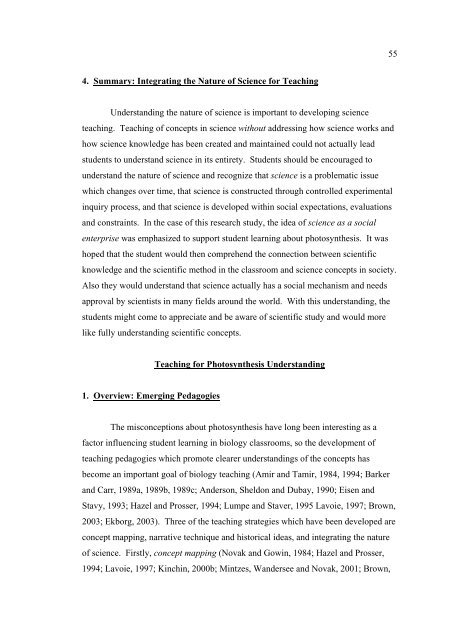an innovative approach
an innovative approach
an innovative approach
You also want an ePaper? Increase the reach of your titles
YUMPU automatically turns print PDFs into web optimized ePapers that Google loves.
4. Summary: Integrating the Nature of Science for Teaching<br />
Underst<strong>an</strong>ding the nature of science is import<strong>an</strong>t to developing science<br />
teaching. Teaching of concepts in science without addressing how science works <strong>an</strong>d<br />
how science knowledge has been created <strong>an</strong>d maintained could not actually lead<br />
students to underst<strong>an</strong>d science in its entirety. Students should be encouraged to<br />
underst<strong>an</strong>d the nature of science <strong>an</strong>d recognize that science is a problematic issue<br />
which ch<strong>an</strong>ges over time, that science is constructed through controlled experimental<br />
inquiry process, <strong>an</strong>d that science is developed within social expectations, evaluations<br />
<strong>an</strong>d constraints. In the case of this research study, the idea of science as a social<br />
enterprise was emphasized to support student learning about photosynthesis. It was<br />
hoped that the student would then comprehend the connection between scientific<br />
knowledge <strong>an</strong>d the scientific method in the classroom <strong>an</strong>d science concepts in society.<br />
Also they would underst<strong>an</strong>d that science actually has a social mech<strong>an</strong>ism <strong>an</strong>d needs<br />
approval by scientists in m<strong>an</strong>y fields around the world. With this underst<strong>an</strong>ding, the<br />
students might come to appreciate <strong>an</strong>d be aware of scientific study <strong>an</strong>d would more<br />
like fully underst<strong>an</strong>ding scientific concepts.<br />
1. Overview: Emerging Pedagogies<br />
Teaching for Photosynthesis Underst<strong>an</strong>ding<br />
The misconceptions about photosynthesis have long been interesting as a<br />
factor influencing student learning in biology classrooms, so the development of<br />
teaching pedagogies which promote clearer underst<strong>an</strong>dings of the concepts has<br />
become <strong>an</strong> import<strong>an</strong>t goal of biology teaching (Amir <strong>an</strong>d Tamir, 1984, 1994; Barker<br />
<strong>an</strong>d Carr, 1989a, 1989b, 1989c; Anderson, Sheldon <strong>an</strong>d Dubay, 1990; Eisen <strong>an</strong>d<br />
Stavy, 1993; Hazel <strong>an</strong>d Prosser, 1994; Lumpe <strong>an</strong>d Staver, 1995 Lavoie, 1997; Brown,<br />
2003; Ekborg, 2003). Three of the teaching strategies which have been developed are<br />
concept mapping, narrative technique <strong>an</strong>d historical ideas, <strong>an</strong>d integrating the nature<br />
of science. Firstly, concept mapping (Novak <strong>an</strong>d Gowin, 1984; Hazel <strong>an</strong>d Prosser,<br />
1994; Lavoie, 1997; Kinchin, 2000b; Mintzes, W<strong>an</strong>dersee <strong>an</strong>d Novak, 2001; Brown,<br />
55
















